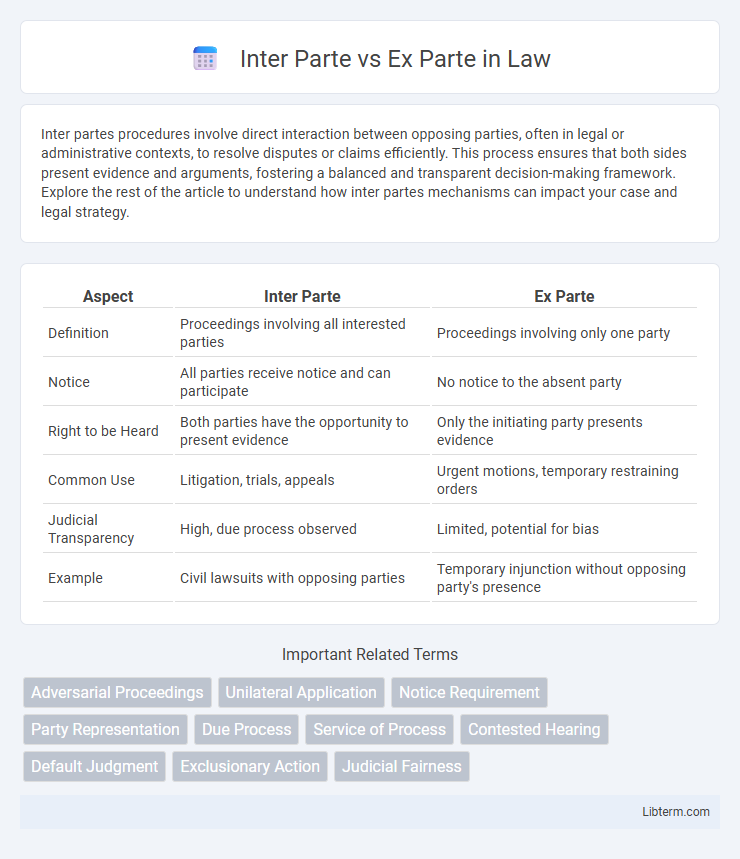Inter partes procedures involve direct interaction between opposing parties, often in legal or administrative contexts, to resolve disputes or claims efficiently. This process ensures that both sides present evidence and arguments, fostering a balanced and transparent decision-making framework. Explore the rest of the article to understand how inter partes mechanisms can impact your case and legal strategy.
Table of Comparison
| Aspect | Inter Parte | Ex Parte |
|---|---|---|
| Definition | Proceedings involving all interested parties | Proceedings involving only one party |
| Notice | All parties receive notice and can participate | No notice to the absent party |
| Right to be Heard | Both parties have the opportunity to present evidence | Only the initiating party presents evidence |
| Common Use | Litigation, trials, appeals | Urgent motions, temporary restraining orders |
| Judicial Transparency | High, due process observed | Limited, potential for bias |
| Example | Civil lawsuits with opposing parties | Temporary injunction without opposing party's presence |
Introduction to Inter Parte and Ex Parte
Inter Parte and Ex Parte are legal terms describing different types of proceedings or communications in law. Inter Parte refers to cases or hearings where all involved parties are present and have the opportunity to participate, present evidence, and argue their positions. Ex Parte involves communication or proceedings conducted by one party without the presence or participation of the other parties, often in urgent or preliminary matters.
Defining Inter Parte Proceedings
Inter Parte proceedings involve a legal process where all parties affected by the dispute are given the opportunity to participate, present evidence, and argue their case. These proceedings ensure fairness and transparency by allowing each party to respond to claims and submit counterarguments, often seen in administrative or judicial reviews. Inter Parte contrasts with Ex Parte actions, where only one party is present without the other being notified or given a chance to defend.
Understanding Ex Parte Proceedings
Ex parte proceedings involve only one party present before the court without notifying or including the opposing party, often used in urgent or emergency situations requiring immediate judicial intervention. These hearings allow a judge to grant temporary relief or orders based on the applicant's representations, emphasizing speed and confidentiality but carrying potential risks of bias due to lack of adversarial input. Understanding the scope and limitations of ex parte proceedings is crucial for legal practitioners to ensure fair process while protecting critical interests in time-sensitive matters.
Key Differences Between Inter Parte and Ex Parte
Inter Parte proceedings involve all interested parties who have the right to present evidence and argue their case, ensuring a balanced and adversarial process. Ex Parte proceedings occur with only one party present, typically used in urgent or preliminary matters where immediate relief is required without notifying the opposing side. The key differences lie in the level of participation, notice to the other party, and the scope of argument and evidence presented.
Legal Significance of Each Process
Inter Parte proceedings involve all parties affected by the legal matter, ensuring procedural fairness and the opportunity for each party to present evidence and arguments. Ex Parte proceedings occur without the presence or notification of the opposing party, typically reserved for urgent matters requiring immediate judicial intervention. The legal significance of Inter Parte lies in upholding the right to a fair hearing, while Ex Parte emphasizes expediency and protection of rights when notice could cause irreparable harm.
Situations Appropriate for Inter Parte
Inter Parte proceedings are appropriate when both parties require a fair opportunity to present evidence and arguments, such as in patent oppositions or trademark disputes where mutual contention exists. These situations demand adversarial engagement, allowing cross-examination and discovery to ensure thorough examination of claims. Inter Parte procedures are essential for resolving conflicts with competing interests, guaranteeing transparency and balanced adjudication.
When to Opt for Ex Parte Proceedings
Ex parte proceedings are appropriate when immediate court intervention is necessary to prevent irreparable harm or when notifying the opposing party could compromise the case, such as in emergency restraining orders or protective custody matters. Courts favor ex parte motions only under urgent circumstances where delay would result in significant prejudice or jeopardize safety. Opting for ex parte proceedings requires demonstrating clear and convincing evidence that the situation cannot wait for a full hearing involving all parties.
Advantages and Disadvantages of Both
Inter Parte proceedings involve both parties, ensuring balanced representation and cross-examination, which promotes fairness but can be time-consuming and costly. Ex Parte proceedings involve only one party, allowing for faster decisions and emergency relief but may risk bias due to lack of opposing input. The choice between Inter Parte and Ex Parte depends on the urgency of the matter and the need for comprehensive evidence evaluation.
Impact on Legal Rights and Outcomes
Inter Parte proceedings involve all affected parties, ensuring fairness and transparency while preserving the legal rights of each participant through the opportunity to present evidence and arguments. These proceedings typically lead to more comprehensive outcomes due to adversarial engagement and thorough examination. Ex Parte actions, by contrast, occur without notifying or involving the opposing party, often resulting in expedited decisions but posing risks to the fairness and completeness of the legal outcome, potentially impacting due process and the right to be heard.
Conclusion: Choosing the Right Legal Path
Selecting between Inter Parte and Ex Parte proceedings depends on the case urgency and the need for opposing party involvement; Inter Parte allows for full adversarial participation, ensuring balanced legal arguments and evidence presentation. Ex Parte is suitable for urgent or sensitive matters requiring immediate judicial action without notifying the opposing party, but it risks bias due to the lack of opposing input. Proper assessment of case specifics and strategic goals is essential to determine the most effective legal path.
Inter Parte Infographic

 libterm.com
libterm.com